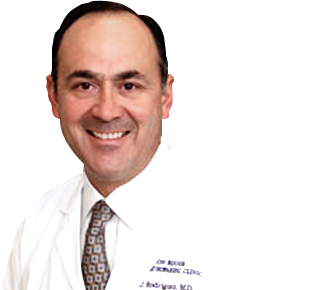- Knee Arthroscopy
- Knee Replacement and Reconstruction
- Patient Specific Knee Options
- Cartilage Restoration
- Others
Knee Arthroscopy

Knee Arthroscopy is a common surgical procedure performed using an arthroscope, a viewing instrument, to consider the knee joint to diagnose or treat a knee problem. It is a relatively safe procedure and most the patient’s discharge from the hospital on the same day of surgery.
Knee anatomy
The knee joint is one of the most complex joints of the body. The lower end of the thighbone (femur) meets the upper end of the shinbone (tibia) at the knee joint. A small bone called the patella (kneecap) rests on a groove on the front side of the femoral end. A bone of the lower leg (fibula) forms a joint with the shinbone.
To allow smooth and painless motion of the knee joint, articular surfaces of these bones are covered with a shiny white slippery articular cartilage. Two C-shaped cartilaginous menisci are present in between the femoral end and the tibial end.
Menisci act as shock absorbers providing cushion to the joints. Menisci also play an important role in providing stability and load bearing to the knee joint.
Bands of tissue, including the cruciate and collateral ligaments, keep the different bones of the knee joint together and provide stabilization to the joint. Surrounding muscles are connected to the knee bones by tendons. The bones work together with the muscles and tendons to provide mobility to the knee joint. The whole knee joint is covered by a ligamentous capsule, which further stabilizes the joint. This ligamentous capsule is also lined with a synovial membrane that secretes synovial fluid for lubrication.
Indications for Knee arthroscopyThe knee joint is vulnerable to a variety of injuries. The most common knee problems where knee arthroscopy may be recommended for diagnosis and treatment are:
- Torn meniscus
- Torn or damaged cruciate ligament
- Torn pieces of articular cartilage
- Inflamed synovial tissue
- Misalignment of patella
- Baker’s cyst: a fluid filled cyst that develops at the back of the knee due to the accumulation of synovial fluid. It commonly occurs with knee conditions such as meniscal tear, knee arthritis and rheumatoid arthritis.
- Certain fractures of the knee bones
Procedure
Knee arthroscopy is performed under local, spinal, or general anesthesia. Your anesthesiologist will decide the best method for you depending on your age and health condition.
- The surgeon makes two or three small incisions around the knee.
- Next, a sterile saline solution is injected into the knee to push apart the various internal structures. This provides a clear view and more room for the surgeon to work.
- An arthroscope, a narrow tube with a tiny video camera on the end, is inserted through one of the incisions to view the knee joint. The structures inside the knee are visible to the surgeon on a video monitor in the operating room.
- The surgeon first examines the structures inside the knee joint to assess the cause of the problem.
- Once a diagnosis is made, surgical instruments such as scissors, motorized shavers, or lasers are inserted through another small incision, and the repair is performed based on the diagnosis.
The repair procedure may include any of the following:
- Removal or repair of a torn meniscus
- Reconstruction or repair of a torn cruciate ligament
- Removal of small torn pieces of articular cartilage
- Removal of loose fragments of bones
- Removal of inflamed synovial tissue
- Removal of baker’s cyst
- Realignment of the patella
- Making small holes or microfractures near the damaged cartilage to stimulate cartilage growth
- After the repair, the knee joint is carefully examined for bleeding or any other damage.
- The saline is then drained from the knee joint.
- Finally, the incisions are closed with sutures or steri-strips, and the knee is covered with a sterile dressing.
After the Surgery
Most patients are discharged the same day after knee arthroscopy. Recovery after the surgery depends on the type of repair procedure performed. Recovery from simple procedures is often fast. However, recovery from complicated procedures takes a little longer. Recovery from knee arthroscopy is much faster than that from an open knee surgery.
Pain medicines are prescribed to manage pain. Crutches or a knee brace may be recommended for several weeks. A rehabilitation program may also be advised for a successful recovery. Therapeutic exercises aim to restore motion and strengthen the muscles of the leg and knee.
Risks and complications
Knee arthroscopy is a safe procedure and complications are very rare. Complications specific to knee arthroscopy include bleeding into the knee joint, infection, knee stiffness, blood clots or continuing knee problems.
Knee Replacement and Reconstruction
- Knee Osteotomy
- High Tibial Osteotomy
- Tibial Tubercle Osteotomy
- Unicompartmental Knee Replacement
- Patellofemoral Knee Replacement
- What is new in Knee Replacement
- Computer Navigation for Total Knee Replacement
- Total Knee Replacement
- Revision Knee Replacement
- Medial Patellofemoral Ligament Reconstruction
- Distal Realignment Procedures
- Arthroscopic Reconstruction of the Knee for Ligament Injuries
- PCL Reconstruction
- LCL Reconstruction
- ACL Reconstruction
- Tricompartmental Knee Replacement
- After Knee Replacement
- Custom Partial Knee Replacement








